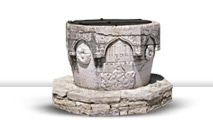
- Sečovlje Salt Pans - Dragonja River Valley
- Sv. Peter - Nova vas - Padna
- Pomjan - Nature Park: Karst Edge - Socerb
- Črni Kal - Osp - Kubed
- Momjan - Grožnjan - Pietrapelosa - Mirna
- Baštija - Kostanjica - Parenzana
- Oprtalj - Završje - Livade - Zrenj
- Istarske toplice - Motovun Forest - Višnjan
- Cave Mramornica - Feštini Kingdom - Cave Baredine
- Lim Bay - Kloštar - Kontija - Dvigrad
- Kanfanar - Bale - Palud - Vodnjan - Brijuni - Fažana
- Svetvinčenat - Tinjan - Pićan - Gračišće
- Belaj - Šumber - Kožljak - Paz
- Čepićko Field - Kršan - Boljun Castle - Lupoglav
- Plomin - Kvarner Gulf - Brseč
- Nature park Učka - Mošćenice
Nature park Učka - Mošćenice
Mošćenice
Medieval fortified town situated on a high hill on the eastern slopes of Učka, offering a spectacular view of the Kvarner and islands. Its beginnings can be traced to prehistoric times when it was settled by the Liburnians, an Illyrian tribe, so today this area, too, is referred to as Liburnia. The inhabitants were mostly cattle breeders and able seafarers who with their characteristic fast liburna ships posed a threat to famed seamen and warriors. After the Romans, in the 7th c. Liburnia was settled by the Croats, and after the fall of the Kingdom of Croatia it became a part of the Kingdom of Germany until the beginning of the 19th c.
The first authentic record of Mošćenice dates from the 14th c. when it is mentioned as an independent commune of the Kastav property.
In the 17th c. it was the property of the Jesuits from Rijeka and had its own town statute. An interesting fact is that all public documents, urbars, notary records, statutes from the 14th - 17th cc. were written in Croatian - in the Glagolitic script. In the Istria-Kvarner region the Glagolitic script achieved the height of prosperity and use.
There are a number of cultural-historical monuments in town, including the Parish Church of St. Andrew, St. Bartholomew's Church from the 17th c. and St. Sebastian's Church from the 16th c. with characteristic porticos, houses of noble families, castle and town gate.


















